Content
Gardeners are consistently in demand for varieties and hybrids of strawberries that are characterized by ease of care, high yield, large size and visual presentation of the berries, and outstanding taste. Strawberry Salsa, which has long been well known to gardeners and farmers not only in Russia, but throughout the world, meets all these criteria.
History of selection
Strawberry Salsa is a variety bred in the Netherlands in 1988 by breeders of the Fresh Forward agricultural company. The authors intended it to be universal, but at the moment it is in demand only by amateur gardeners and private farmers. Strawberry Salsa is not currently grown on an industrial scale - it is a rather old variety, it no longer withstands “competition” from new breeding products, which were originally created as commercial ones.
Description and characteristics of Salsa strawberries
Salsa is a universal-purpose, non-repairing variety of strawberry.The bushes are powerful, the rosette of leaves is erect, high (about 30 cm), but the plants are relatively compact (20-25 cm in diameter). The leaves are of typical size and shape for the crop, bright green in color.
The flowers are large, with a lot of pollen. The flower stalks rise slightly above the rosette at the bud formation stage; after the ovaries form, they gradually droop under the weight of the berries. As a result, they seem to “hide” under the leaves.

Despite the compactness of the Salsa strawberry bushes, its plantings in the beds cannot be compacted
Characteristics of fruits, taste
From the photos and videos it is obvious that the size of the Salsa strawberry berries varies from large to very large. In the first wave of fruiting, their average weight is 50-60 g, then they “shrink” to 30-40 g. The shape is generally regular, blunt-conical, the largest ones can be flattened, comb-shaped.
The skin of the berries is thin, glossy, and has a classic “strawberry-red” hue. A white “border” is clearly visible under the highly raised sepals. The seeds are quite large, strongly pressed into the pulp.
The pulp is pale pink, medium density, but quite fleshy and highly juicy. The taste is balanced, sweet, with a noticeable refreshing acidity. The purpose of the fruit is universal. Strawberry Salsa can be eaten fresh, used as a filling for baked goods, an ingredient for fruit salads and cocktails. It is suitable for home canning and drying.

Ripe Salsa strawberries can be distinguished from unripe ones by their pronounced pleasant aroma
Ripening time, yield and keeping quality
Salsa is a late-ripening variety of strawberry. The ripening process of berries lasts an average of 110 days. Flowering is also later - 25-30 days after the leaves appear. The first “massive” wave of fruiting occurs in the last ten days of June. From the moment the ovaries form until harvest, about 30 days pass.
Strawberry Salsa is a highly productive variety. The average yield of an adult bush per season is 1 kg. At the same time, to achieve such indicators, it does not require careful care; even individual “flaws” in agricultural technology are possible.

If you create optimal conditions for strawberry Salsa, its yield increases by about 1.5 times
Growing regions, frost resistance
Due to its cold resistance, Salsa strawberries can be grown almost throughout Europe, including its north and center. In Russia, it is successfully cultivated not only in the middle zone, but also in more severe conditions - in the Urals and Siberia.
The experience of gardeners shows that when the snow cover is 10 cm thick or more, the Salsa strawberry overwinters “painlessly” or with minimal damage at a temperature of -25-30 °C. If there is little snowfall, the plants will most likely be seriously damaged already at -10-12 °C, and will die at -15-20 °C.
Resistance to diseases and pests
The variety does not have “innate” immunity to fungal and other diseases, but is characterized by good resistance to pathogenic microflora.Cultivation experience shows that plants are extremely rarely affected by late blight, verticillium, peronospora and powdery mildew.
The most dangerous for Salsa strawberries are various types of spots and root rot. But they also appear only if you completely refuse to care for the bushes or make very serious mistakes in agricultural technology. Another risk factor is long-term weather conditions, which favor the activation of pathogens.
Advantages and disadvantages of the variety
Photos and reviews from gardeners confirm the description of the originator, who notes that the strawberry variety Salsa has the following advantages:
- undemanding to care and cultivation conditions;
- consistently high productivity;
- successful resistance to some diseases typical of the culture, rare cases of insect attacks;
- cold resistance is good even for Russia;
- late fruiting periods;
- “responsiveness” to quality care;
- large-fruited, externally presentable berries;
- outstanding taste, “balance” of sugar and acidity;
- versatility of berries.

The large-fruited and aesthetically pleasing berries help Strawberry Salsa remain in demand among amateur gardeners
Strawberry Salsa also has some significant disadvantages:
- sensitivity to humidity levels;
- the almost inevitable development of chlorosis when planting in an alkaline substrate;
- an increasing risk of infection with rot and various types of spotting if care is neglected;
- low shelf life and transportability;
- softness and juiciness of the pulp.
The tendency of Strawberry Salsa to actively form a mustache can be considered both an advantage and a disadvantage. There will definitely be no problems with its reproduction, but you will have to regularly spend time and effort to prevent the thickening of the plantings.
Reproduction methods
Strawberry Salsa is distinguished by the presence of a large number of powerful whiskers. Planting material for this variety is guaranteed not to be in short supply. In principle, it can be propagated by dividing the bush and growing from seeds, but this is impractical due to the large investment of time and effort.

The “daughter” rosettes of the Salsa strawberry develop quickly, in the vast majority of cases they successfully take root in a new place
To get a new specimen, it is enough to “substitute” a small pot or plastic cup filled with a loose but sufficiently nutritious substrate under the selected mustache and “pin” it to the soil. By mid-August, new rosettes can be separated from the mother plant and transplanted into a previously prepared bed.

New strawberry seedlings Salsa from pots or cups are transferred to the garden bed by transshipment
Planting and care
For planting, choose a bed that is well lit by the sun, protected from cold winds and drafts. Areas with groundwater close to the soil surface and lowlands are not suitable - constant waterlogging of the soil ensures rotting of the roots.
Strawberries Salsa can grow and even bear fruit in almost any substrate, but large yields of large berries can be harvested only if it is fertile, loose, with a pH close to neutral.When preparing the bed, it is recommended to improve the quality of the soil by adding humus (4-5 l/m²) and complex specialized fertilizer (8-10 g/m²) during the digging process. You can also use “natural” sources of potassium and phosphorus - dolomite flour, sifted wood ash.

In a properly planted strawberry, the “heart” remains at ground level.
Caring for strawberries Salsa is limited to standard agrotechnical measures:
- Watering. For this variety, both prolonged droughts and a “swamp” in the garden bed are harmful, so the intervals are determined based on the condition of the soil, allowing its surface layer to dry out. On average, in hot weather, bushes are watered every 3-4 days, in cool weather - weekly. The approximate norm is 2-3 liters per plant.
- Since Salsa strawberries are prone to developing root rot, they need loosening every 7-10 days, even in mulched beds.
- Feeding. Strawberry Salsa responds positively to any fertilizer applied on time and in the right dosage. As soon as the leaves begin to bloom, it is provided with nitrogen, stimulating the formation of green mass. In mid-May, at the stage of bud formation, berry set and after the first wave of fruiting, complex fertilizers for strawberries or any folk remedies containing potassium and phosphorus are applied. The last feeding with the same macroelements is applied in preparation for winter.
- Trimming. It involves regular removal of the mustache. Otherwise, the bed quickly becomes overgrown, which negatively affects the yield and quality of the fruit.
- Prevention of diseases.At the beginning of the growing season and in mid-autumn, it is recommended to spray the plantings with a solution of any fungicide. During the season, treatments are repeated if weather conditions favorable for the activation of pathogenic fungi persist for a long time.
The mulch in the beds with Salsa strawberries is changed 2-3 times per season, not allowing it to “smudge”
Preparing for winter
When preparing Salsa strawberries for winter, it is not recommended to cut off the leaves - they become additional thermal insulation. The bed, cleared of plant debris, is covered with fallen leaves, straw, pine branches, and covered with 2-3 layers of covering material.

Snow piled on top will additionally “warm” the soil, but several times during the winter the snowdrift will have to be loosened, breaking up the crust that forms.
Conclusion
Strawberry Salsa, like most late varieties, is distinguished by its general endurance, “stress resistance” and consistently high yield. It is popular both among amateur gardeners and owners of private farms. The variety is undemanding in terms of care, but in order for it to perform at its best, important nuances of agricultural technology will still have to be studied.
Reviews from gardeners about Salsa strawberries








